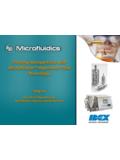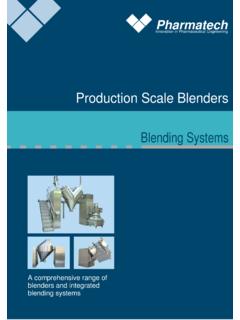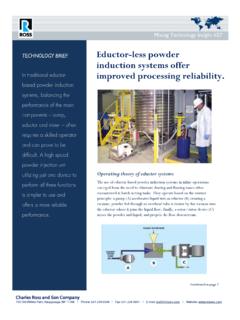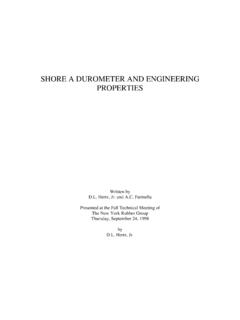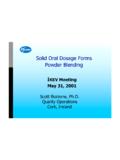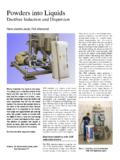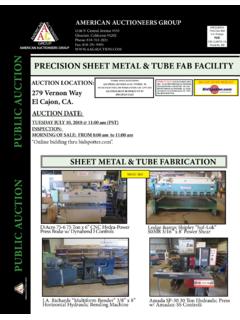Transcription of Small mills in Africa - Food and Agriculture …
1 AGRICULTURAL AND. FOOD ENGINEERING. WORKING DOCUMENT. 5. Small mills in Africa Selection, installation and operation of equipment AGRICULTURAL AND. FOOD ENGINEERING. WORKING DOCUMENT. 5. Small mills in Africa Selection, installation and operation of equipment by Brian Clarke Alexandra Rottger FOOD AND Agriculture ORGANIZATION OF THE UNITED NATIONS. Rome, 2006. The Agricultural and Food Engineering Working Document disseminates findings of work in progress to encourage the exchange of ideas and experiences related to agricultural and food engineering within agri-food systems. The series aims to bring the findings to the public domain as quickly as possible, even if the presentations are less than fully polished. The papers carry the name of authors and should be used and cited accordingly. The findings, interpretations and conclusions are the author's own.
2 The designations employed and the presentation of material in this information product do not imply the expression of any opinion whatsoever on the part of the Food and Agriculture Organization of the United Nations concerning the legal or development status of any country, territory, city or area or of its authorities, or concerning the delimitation of its frontiers or boundaries. All rights reserved. Reproduction and dissemination of material in this information product for educational or other non-commercial purposes are authorized without any prior written permission from the copyright holders provided the source is fully acknowledged. Reproduction of material in this information product for resale or other commercial purposes is prohibited without written permission of the copyright holders. Applications for such permission should be addressed to: Chief, Publishing Management Service Information Division FAO.
3 Viale delle Terme di Caracalla, 00100 Rome, Italy or by e-mail to: FAO 2006. iii Contents vi Preface .. vii List of viii Glossary .. viii 1. Introduction .. 1. 1. Objectives of 2. 2. Hulling .. 3. Principles of 3. Different types of hullers .. 3. Use of different types of hullers .. 4. 3. Milling .. 5. Principles of milling .. 5. Mechanism of fracture of a 5. Effect of moisture content on the fracture of a grain .. 5. Different types of Small milling 6. Hammer mills .. 6. Plate 7. Comparison of milling 8. Product 8. Technical 8. Purchase 8. 4. Investment 9. Ownership considerations .. 9. Feasibility 9. Profitability calculations .. 10. Income .. 10. Operational costs .. 10. Capital 10. Summary of 10. 5. Mill installation .. 13. Building requirements for a Small mill .. 13. Power 14. Fuel-driven 14. Power-driven engines .. 14. Renewable energy 14.
4 Combined use of engines .. 14. Recommendations for 14. 6. Operation and maintenance .. 17. Daily maintenance .. 17. Periodic maintenance .. 17. Maintenance records .. 18. iv Safety Annexes 1. Manufacturers of Small mills ..21. 2. Useful Web site links ..23. v List of figures 1. Typical structure of a cereal grain .. 2. 2. Compression and shear of dry grains .. 5. 3. Compression and shear of moist 5. 4. Locally made hammer mill and its typical construction .. 6. 5. Locally made plate mill and its typical 7. 6. Typical mill-room 13. List of plates 1. Traditional rubbing and hand grinding stones .. 1. 2. Women at work .. 1. 3. Different types of 3. vi Acknowledgements Sincere thanks go to Peter Steele and Jose Machado of FAO for their direction and guidance in initiating this working document. Richard Morgan and David Dunn both reviewed the draft manuscript in some detail and their contributions are also gratefully acknowledged.
5 Similarly, thanks also go to John Parkinson, currently working with World Vision, for his wise comments and invaluable advice, and to Joe Morris of Silsoe College, Cranfield University, the United Kingdom, for his expert advice on the economics of Small -scale milling. Finally, the assistance of Larissa D'Aquilio and Julian Plummer in the preparation of the document is gratefully acknowledged. vii Preface Small mills are very important machines for many communities in Africa as they eliminate much tedium and time-consuming labour. Various types of Small mills are found across Africa . While considerable literature is available on the technologies of medium- and large-scale mills , there is little information on Small -scale mill technologies and on how to make the right purchase decision. This working document includes information on various types of hullers and Small mills available in Africa .
6 It advises how to select milling equipment, and how to install, operate and maintain Small mills . It includes simple profitability calculations. This document is designed to be comprehensive and practical. It is addressed to entrepreneurs or communities who want to invest in a mill and to extension workers, national and international development organizations, and rural finance institutions involved in advising potential investors. viii List of acronyms kg Kilogram kW Kilowatt m Metre mm Millimetre US$ United States dollar Glossary Aspiration: removal of lighter parts of a grain by air current. Awn: spiked part of the husk at the end of a grain. Endosperm: energy-rich starchy centre of a grain. Feed: part of the grain used for animal feed. Flour: a fine powder made from grain. Grinding: breakage of coarse grains into smaller pieces. Hulling: (dehulling, husking or dehusking) removing the fibrous outer shell and the bran from the surface of a grain.
7 Husk: fibrous outer shell of the grain. Meal: crushed grain with a coarser texture than flour. Milling (grinding): production of flour from cereals, seeds, dried root crops and nuts. Pericarp: tough outer layer of grain beneath the husk. Shelling: removing maize corns from the cob. Toxins: poisonous residues and growths that can contaminate grain. Winnowing: separating he chaff from a grain by employing air 1. Chapter 1. Introduction BACKGROUND. The earliest records of food production in Africa Plate 1. show that indigenous crops have long been FAO/B. CLARKE. milled to produce coarse flour for cooking. Traditional crops such as yam, sorghum, millet and teff have been ground for centuries either with a crude mortar and pestle fashioned from a tree stump and branch or by using flat stones or rubbing stones (Plate 1). All these types of grinding systems are still in common use throughout Africa today.
8 Newer crops, such as rice, maize and cassava, have been introduced in more recent centuries, and new milling techniques have followed. In the mid-nineteenth century, electric motors were invented and higher speed machines, such as hammer and plate mills , began to replace traditional stone mills . As electricity became available in many parts of Africa , motor-driven Traditional rubbing and hand mills gained in importance. However, it was not grinding stones until the introduction of the diesel engine in the early twentieth century that high- speed mills were seen in more significant numbers across the continent. A relatively low-speed, water-cooled diesel engine can, for example, power a hammer mill, producing maize flour of acceptable quality. These mills are in widespread use in rural parts of the world in areas where no electricity grid is available.
9 Diesel- powered grain mills are limited to areas with access to fuel and spare parts. Many people still cannot afford paying for Plate 2. commercial grain-milling services and they grind by hand using traditional techniques. Therefore, pounding is a common sight and sound in many areas. It is often a social activity, carried out predominantly by women (Plate 2), and many hours are spent each day in this laborious and time-consuming task. The pestle may weigh up to 4 kg, and pounding requires a lot of effort. The stone mill or quern, either hand-, animal- or motor-driven, is relatively unknown in Africa despite having given good service in many other countries. This machine operates on the same principle as plate FAO/B. CLARKE. mills but uses large stones instead of plates and is set with a vertical axis. The skills of dressing stones have not been acquired in areas where appropriate stones have not been easily available.
10 However, there are isolated examples of stone mills in Africa that are well Women at work designed for using low-speed animal power. 2 Small mills in Africa Larger-scale mills are in operation in most FIGURE 1. African countries today. They mainly supply Typical structure of a cereal grain flour to larger cities and towns. These mills use fluted roller mills that operate to a higher technical standard than Small -scale mills do. They can remove bran and wheatgerm, producing refined white flour mainly for bread making. Larger-scale roller mills are also used to mill maize into grits. OBJECTIVES OF MILLING. The main objective of milling is to improve the digestibility of the grain for human or animal consumption. A typical grain (Figure 1) is surrounded by a hard coat or Source: FAO/B. Clarke. husk, which protects the germ and the endosperm, the energy-rich starchy centre of the grain.










